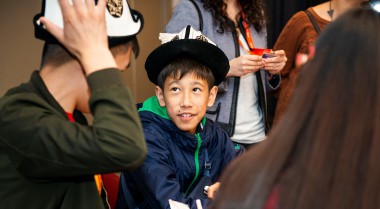
Visions for sustainable and youth-led peace ahead of the Peacebuilding Architecture Review 2025
Imagine if an owner of a small business came to the United Nations and said ‘Today, we will implement my plan to solve all of your problems’!
This is analogous to how the UN and the donor community approach their support to countries and their people. They assume they can solve the problems of people regardless of their culture, history and realities that this country’s own youth better understand and know.
Youth are part of the peacebuilding process from the beginning till the end. And today I will share some points to have more effective youth engagement in peacebuilding and development processes.
Let me start with a reflection back to 2020.
One of the biggest accomplishments of the 2020 Peacebuilding Architecture Review (hereafter, the Review) was the recognition by Member States that peacebuilding policy and practice have to be measured in terms of impact rather than outputs. At GPPAC we have witnessed that peacebuilding impact does not happen overnight and cannot be immediately captured; it takes time for the long-term changes that these activities create to become evident. We believe that the 2025 Review presents an opportunity to turn the recognition of the value of impact into practice.
When it comes to young peacebuilders’ work, there is no doubt about the impact they make. For example, young peacebuilders in Tripoli, Lebanon organised a soccer game for children - who were about 12 years old and came from neighbouring cities that were in conflict with each other. Through this game, children from conflicting cities created strong bonds between them and helped their parents to do the same. This example clearly demonstrates how youth-led initiatives can transform communities and foster lasting peace.
The 2025 Review can contribute to the long-delayed shift in the mindset towards trusting young peacebuilders and working alongside them to bring about the objectives of sustaining peace.
This is especially important since previous PBARs did not have a strong focus on YPS. Please allow me to propose three points for your consideration:
First, the international community needs to think about how to involve young people meaningfully in the Review from the outset of the process.
There is a Lebanese proverb that says: ‘The person who is being beaten is not like the one who is counting the beats for him’. In the current war on Gaza and Lebanon, we as local peacebuilders in the country were trying to flee with the people we serve to less endangered areas in the country. We are always under the threat of having rockets shouted at us, our tomorrow is very blurry. Yet I heard people in the previous UN meeting from people living in very stable and peaceful places that there should be laws for peacebuilders’ protection in our countries. You are right, but in our countries, even the order to install street lights is more of a suggestion and people don’t abide by any policies or orders. Will having protection guidance make a difference in the context when the basic needs are not met? Experiences of those living in conflict bring realistic solutions, and youth of these locations with their creativity are the best fit to find impactful solutions. Local independent youth committees, if supported by the UN, would make a real change.
The international community is already delayed on the involvement of young people in the Review of the SDG implementation, potentially risking us sitting in 2030 and reflecting on another missed chance to include young people. All donors, UN agencies, funds and programmes and governments have to have an independent Youth Committees or Advisory Boards (or at least a representative - selected by inclusive umbrella organisations) to inform their strategic cycle. This similarly applies to the Review process while each actor thinks about designing their engagement. These positions have to be financially supported by external donors as a matter of priority to allow youth to be truly independent.
Second, there is a need to understand how to implement localisation.
Localisation has become a buzzword within the international community, as stakeholders observe that the insights from local partners about their interventions are often accurate and valuable. In this, young people’s visions for their own countries and regions cannot be left out. A group of Egyptian youth realised that having a space to study together increases their level of understanding of their courses and helps them get better results. So they decided to ask for funds to start working on having this space. They attempted to get resources from the UN but they were told that the theme for this agency’s funding is for ‘animal welfare’ that year. This might look like an exaggeration, but in fact, youth experiences are the last consideration when it comes to donors’ decision-making.
Young people’s views have to be considered when deciding how to invest financially or politically in a specific context. How can we be entrusted to develop our own work that responds to our own priorities? Often, the solution is to apply for pooled funds, where the threshold for eligibility for many of such grants is above $300K? What youth-led organisation is eligible for that? There are very few intermediary partners, GPPAC included, that allow for unrestricted funding for local organisations without cumbersome due diligence procedures. Scaling up these models may be a short-term solution to the real empowerment of young people, but at the end of the day, donors should turn their gears towards funding young people directly.
Finally, there must be a proper assessment of the effectiveness of existing mechanisms for supporting young peacebuilders.
The Missing Peace report, the first and only progress study, was launched in July 2018 - precisely 6 years ago. Since then, the international community has made progress with the adoption of the PBC’s Strategic Action Plan on Youth and Peacebuilding, the adoption of a resolution on financing for peacebuilding with young people, and the establishment of the Youth Office at the UN. A second independent progress study on the implementation of the YPS Agenda, if undertaken as part of the Review, can help to look constructively at what are the mechanisms, how they are working, and what needs to be done to deliver the aspirations of the YPS Agenda.
In conclusion, I would like to remind you that dual resolutions in 2020 called for a comprehensive review of the peacebuilding architecture with a focus on impact. This is not possible without young people being part of the process and the implementation of the YPS Agenda put diligently under the Review.
Thank You.
I delivered this statement on 11 July 2024 during a side event hosted by the Government of Finland and the Finnish Agenda2030 Youth Group titled ''Visions for sustainable and youth-led peace ahead of the Peacebuilding Architecture Review 2025.''


